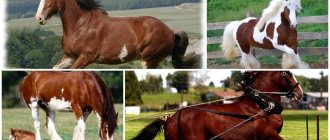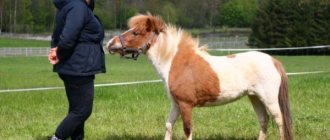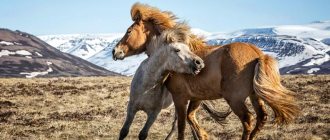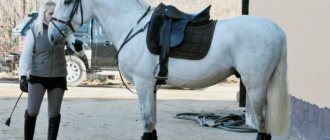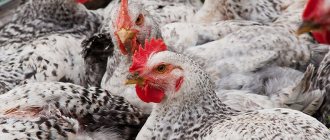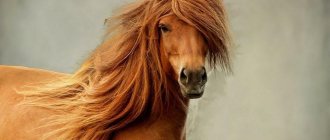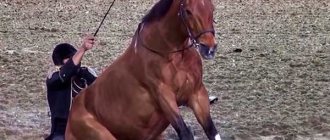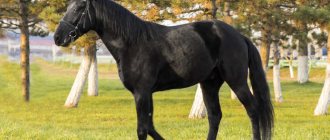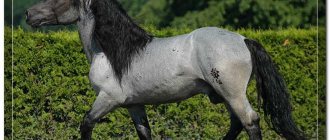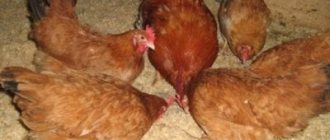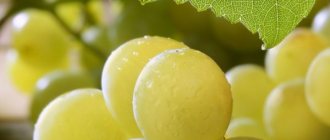Tinker (other names: Irish Cob, Gypsy Harness, Irish Working, Irish Piebald) - a breed of horse bred in Ireland. Tinker is the German and Dutch name for this breed. The Irish do not use it, as the gypsies consider this word offensive. Here the more common name is "kob". This term refers to a horse that is short, stocky, massive and tightly built.
Not so long ago this breed was unknown. But now this is not the case at all. Kob is famous in almost every corner of the world and is becoming more and more popular. These animals are most popular in America. They, like Friesian horses, have a very high cost. While a horse of a less famous breed is valued at up to a thousand dollars, a Tinker or Friesian costs between ten and twenty-five thousand dollars.
A little history
The Tinker horse, like many other draft horses, was bred using the method of folk selection. For the first time, such horses began to be kept in Ireland. In the 15th century, nomadic gypsies arrived in this country in large numbers. They, of course, brought their horses with them. Gypsy horses, since they were never pampered, were very hardy and unpretentious.
Over time, in Ireland these horses began to be crossed with local ones. As a result, the unpretentious Tinker was bred. Since the gypsies are a nomadic people, almost all breeds of horses bred at that time in Ireland took part in the creation of this variety. The ancestors of Tinkers can be considered, for example, Welsh ponies of all types: Highlands, Fells, Dale and, of course, Shires.
For a long time, this gypsy horse breed was unrecognized. It was officially registered only in 1996. The standards of the breed were then determined by the exterior of a stallion named Kushti Bok, who has since been considered its founder.
General description of Tinker horses
What do these unusual horses look like? Tinker is not a riding horse, but a draft horse. Therefore, she is not distinguished by too graceful body shapes. Tinkers are medium in size. Their head is massive and rough, with a beard. The profile of these horses is humpbacked, and the bangs and mane are very thick.
The features of this breed, among other things, include:
- short and strong neck;
- short and straight back;
- powerful shoulders;
- strong muscular croup.
You can recognize these horses, among other things, by the thick friezes on their hooves, which start from the hocks and reach almost to the ground (photos of Tinker horses are presented in the article). As you can see, these shaggy beauties actually look very impressive.
Color
The Irish nobility once treated tinkers with contempt because of their piebald coloring. The military of this country did not want to buy horses that looked like cows. The gypsies, on the contrary, really valued this particular color. Piebald horses, including tinkers, usually have strictly individual colors. Therefore, in the event of theft, such a horse would always be easy to identify at the market.
There are currently three recognized color types for Tinker horses:
- overo;
- tobiano;
- tovero.
An interesting feature of representatives of this breed, among other things, is the fact that their skin in those areas where the coat is colored white is always pink. In addition to piebald tinkers, there are also dappled, black and roan tinkers.
Piebald
There are three varieties of Irish pinto. It is impossible to single out the brightest and most beautiful of them, because the color makes the horse inimitable and unique.
We pack gifts: run an iron over a napkin and cling film
In Russia, the number of beauty salons decreased by 10% over the year
To prevent children from quarreling, parents built an unusual bunk bed
- Overo. This coloring is characterized by the presence of asymmetrical white areas throughout the body.
- Tobiano. These horses have dark sides, white legs, and rich round spots on the neck and chest.
- Tovero is a suit that combines both colors.
Character of horses
The history of the origin of the Tinker horse breed is very old and interesting. These horses were brought out, as we found out, by gypsies. And they are valued by breeders and horse lovers not only for their unpretentiousness and endurance. The undoubted advantages of this breed include the calm and often even phlegmatic nature of its representatives. Tinker horses are obedient and kind, they love their owners and treat all animals in the farmstead well, including other horses.
Mares of this breed are very good mothers. They have a lot of milk, and the foals are always under supervision.
Gypsy Tinker horses are often kept by breeders of elite riding horses. Such animals, of course, cannot take part in races. But they are sometimes used as mounts, although their running speed is not very high. Racehorse breeders keep Tinkers for a different purpose.
At stud farms, mares of this breed are given elite riding foals. Their parents often do not have an easy-going disposition. Therefore, it is believed that calm tinkers in the process of education (as they say, with mother’s milk) have a very beneficial effect on elite young animals.
Lifestyle of gypsy sled dogs
Habitat
A horse breed like Tinker is not demanding in anything, this is due to the history of its development. As mentioned above, the gypsy camps and tribes that bred this breed did not bother to keep stud books and did not use the services of veterinarians. If the foal was weak and sick, it was immediately sold for little money to an unknowing person, thus the herd of tinkers consisted of the hardiest and strongest individuals, undergoing a kind of “natural selection”. The horses did not see warm stables, did not eat fresh greens and cereals on a strict schedule, and did not receive the necessary minerals and vitamins. Therefore, the breed adapted over time to any climate and environment.
Nutrition
The gypsy way of life also left its mark on the nutrition that Tinker needs. Today this breed of horse is so expensive that it can be compared with the Frieze. And these horses began their journey from the time when they ate along the way, whatever they had, whatever came under their feet. Therefore, when compiling a diet for this horse, you can adhere to generally accepted standards and build on the animal’s lifestyle and activity. To maintain the horse's energy and strength, in the summer it needs walking in the fresh air and fresh greens as food; in the winter, this food will be replaced by collected hay. In addition to grass, horses need grains, such as oats and rye, wheat and other valuable crops. Vegetables, such as potatoes and beets, carrots, root vegetables and various concentrates recommended by veterinarians, will be useful for the full functioning of the horse. A horse of this breed eats about 5 times a day, it all depends on how active and productive a lifestyle he leads.
Care
Since the Tinker is a breed of horse that is famous throughout the world for its mane and bushy tail, the owner should devote most of his care to the hair. Two to three times a week, your hair should be cleansed with a special shampoo and conditioner that will give coarse horsehair smoothness and shine. During walking and active pastime, it is better to braid your mane; at night, your hair should be allowed to rest in a loose state. Every time you change your hairstyle, your horse's hair needs to be combed out.
Tinker horses should be shown to a veterinarian twice every six months as a preventive measure for disease. Special attention is required to the hooves and nostrils, which must be washed after walking and thoroughly dried from moisture. A humid environment provokes the formation of infections. If a horse spends a lot of time racing and harness riding, his limbs need a contrast shower that will relieve fatigue and invigorate him after hard everyday life.
Habits and disposition
Making friends with Tinker will not be difficult, since in their temperament and disposition they are phlegmatic and so calm that, it would seem, nothing in the world can make a horse lose its temper. As practice shows, the Gypsy Cob is an ideal horse for a novice rider. Hippodromes and horse races are also not complete without tinkers, who accompany the horses and balance temperamental individuals with their calmness. And Tinker mares are used to feed stallions of riding thoroughbred horses, as they are much calmer and more resilient in nature.
Main purpose of the breed
Tinkers are used on farms, of course, most often as draft horses. That is, for the transportation of various types of cargo. Tinker horses are also in great demand in the tourism business. These horses look incredibly impressive. That’s why they are often harnessed to pleasure carts for tourists at various resorts.
In some cases, as already mentioned, tinkers can also be used as riding horses. The advantages of these horses, among other things, include a soft, comfortable gait. At a gallop, such horses, unfortunately, get tired very quickly, but at the same time they can easily overcome various obstacles. For example, ditches and ditches do not frighten these horses at all.
Scope of application
The Tinker sled breed is versatile. Animals are used in the following areas:
- Horseback riding. The horses have a soft gait and a calm disposition; they are comfortable to control. Such a riding horse is indispensable for training children and inexperienced riders, as it does not create dangerous situations.
- Transportation of goods. Kobs are distinguished by endurance and tirelessness, they feel great in a harness, so they often push carts with tourists.
- Hippotherapy. Kind-hearted Tinkers help cure illnesses. This technique is recommended for autists, patients with musculoskeletal disorders and those suffering from neuroses.
- Supporting the morale of horses . In sports arenas, gypsy cobs are brought out to accompany racing horses. The determination of tinkers is transferred to the excited horses.
- Nurses. Due to their peaceful disposition, mares are tasked with feeding purebred foals.
How much do they cost and can I buy them in Russia?
The Irish Cob Association is currently supporting this breed. This breed is very impressive, fashionable and quite in demand. However, tinkers gained their popularity relatively recently. That is why such foals are currently very expensive. Abroad, those wishing to get such a beautiful and interesting horse will have to pay at least 10-25 thousand dollars for a purebred little tinker. This amount is, of course, huge.
In Russia, a horse of this breed is currently quite difficult to find. However, some breeders still sell such foals. For example, in our country Tinkers are bred in Karelia. Foals of this breed are brought to Russia from Holland, Ireland and England. In the Russian Federation, the cost of adult Tinker horses starts from approximately 350 thousand rubles.
How to care
These horses are very unpretentious in maintenance. Even a novice amateur can take care of a Tinker. The accommodations for these beauties are the same as for any other sled dogs. The same applies to the diet of horses of this breed.
The only downside to caring for Tinkers is that their owner will have to pay some attention to their thick bangs, mane and friezes. The hair of these horses should be washed periodically using shampoo and a special conditioner, then combed thoroughly. Before going on walks, Tinkers usually have their mane braided.
Also, the owner of such a horse must monitor the condition of his hooves. The gypsies never shod their horses before. So Tinkers have strong hooves. But, of course, the owners of such horses still need to use the services of a farrier.
Interesting Facts
Tinkers are a truly unique and quite unusual breed. This is evidenced by various interesting facts about her:
- The name of the breed did not appear by chance. This is exactly what the owners of these horses – gypsies – were once disparagingly called in Ireland. Currently, the word "tinker" is not used in this country. Such horses are called cobs here.
- Some representatives of this breed have so-called magpie eyes. That is, their iris is devoid of pigment.
- Very often, horses of the breed are confused with Shires. And indeed, in appearance they are very similar. But Shires are still more bulky and powerful horses. In addition, piebald coloring is rare for them.
It can also be considered interesting that the gypsy draft horse of the Tinker breed is very often used to pacify evil Arabian horses. Often these short, phlegmatic handsome men even accompany them to the starting boxes at the races.
Horse breeding: Giants of the equestrian world: Irish Cob. Gypsy legend from the shores of Albion
Gypsy ballad
“Don’t buy a horse from a gypsy, don’t take a daughter from a priest,” - this is what any Russian peasant from the times of Mikhail Yuryevich Lermontov or Lev Nikolaevich Tolstoy could say. And, of course, there were reasons for this. In Russia, and in all other countries where the nomadic people were scattered, the gypsies were never overly scrupulous about other people’s property: they were guilty of deceit, and in general they did not arouse much sympathy among the settled inhabitants. The Russian language even included such an unusual verb as “gypsy”, including “gypsy with horses” - that is, to sell and resell horses with a dubious history and not the most remarkable qualities. Since contemporaries write about this, and the expression itself has been preserved in people’s memory, it means that this really happened. But with all this, the gypsies were and still remain first-class horsemen who know a lot about good horses and know how to handle them. In equestrian circles you can often hear stories about the amazing abilities of some gypsy, who either cools down an unfamiliar stallion with one word, or calms a frightened mare with a single touch. Some of this “folklore,” of course, is inspired by the romantic image of the “last nomads of Europe,” created in our minds by A.S. Pushkin, but some has a real basis. Be that as it may, the gypsies left us an absolutely amazing breed, the potential of which is just beginning to unfold, and this alone makes us respect the freedom-loving Roma people.
The history of the Irish cobs, or gypsy draft horses, probably began many thousands of kilometers from Ireland. Today there is little doubt that the roots of the gypsies are in India. When, how and why part of the population of this ancient country uprooted and moved west remains unclear. But already in the 12th-13th centuries, the gypsies firmly settled in Byzantium, after which they first learned about the “vagrants from the east” in Europe. Over the next centuries, the gypsies settled throughout the continent and at the beginning of the 15th century they reached the British Isles. However, here they encountered another tramps, who were called “tinkers” here, i.e. “soldering workers”, “tinkers”. If everything is clear with the name of these English travelers - they, like the gypsies, were mainly engaged in metal processing, then their origin is shrouded in darkness. Were these the original inhabitants of Britain or just the first wave of gypsies unknown to us? Now this is no longer so important, because the Roma people have completely occupied the niche of Tinkers, taking away even the name from them.
The gypsies, of course, came to the islands along with their horses, without which it is impossible to imagine a nomadic lifestyle. Here they began to crossbreed with local breeds, which eventually led to the appearance of Gypsy Kobs. It so happened that it was in Ireland that wandering musicians, magicians, acrobats and tinkers were able to create one of the best draft horses in the world. Although it was not easy...
Toughie
As breeders, the gypsies of that time were limited in everything. Their poor lifestyle did not allow them to maintain expensive breeding horses; constant migrations and scattered connections between camps did not at all contribute to the systematic selection of sires. What could happen in such a situation? Just a good workhorse... That's what it turned out to be! Not just good quality, but excellent.
The gypsies needed reliable, unpretentious and hardy horses, which, in the absence of systemic artificial selection, actually took place in the camps under much stricter natural selection. Traditional gypsy crafts never offered much of a chance to get rich, so the basis of the breed was piebald animals - the cheapest in Europe at that time. Breeders were happy to sell such “substandard” horses for pennies, without even bothering to find out their real qualities. And these horses were not mobilized into the army: what English officer would want to sit on a horse “under a cow”? However, the gypsies never shared this attitude towards piebald horses and always considered them very elegant.
Almost all the breeds bred at that time in the British Isles left their mark on the Irish Cobs: Welsh Cobs, Dales, Fell, Highland, Clydesdales and Shires. In general, a cob is always a short, stocky draft or riding horse (cob - “large nut, stalk,” in general, something strong) - just what the gypsies needed. During long journeys from place to place, only such horses could pull a wagon non-stop, and quickly recover on pasture during the night. Tinkers did not know what a stable was, good oats, and often even horseshoes. There is no need to talk about veterinarians. It was easier to sell a sick horse to some simpleton than to treat it using the available funds, which were barely enough for one’s own food. This spartan lifestyle and heavy loads turned the gypsy kobs into amazing animals. They are very calm, hardy, and require only basic care. And at the same time incredibly beautiful.
Pinto gold
Irish gypsies love their horses very much and often call them their treasure. However, Europeans were always more interested in papers, and therefore the status of a separate breed was not recognized for a long time. The tramps really did not keep any pedigree books, did not issue documents, and in general, according to experts, treated the selection process extremely irresponsibly. So until the Americans on the other side of the ocean took and even assigned the status of a separate breed to Indian brown horses, the appearance of a “Gypsy draft breed” in European reference books seemed simply unthinkable. Today this is a fait accompli, which if anyone raises objections, it is only before their first acquaintance with these beautiful creatures.
The history of the development of the breed was very complex, so the kobs vary greatly in their measurements. The height of Gypsy Kobs can vary from 135 to 160 cm, and weight - from 240 to 700 kg. But usually these are horses of medium height with a slightly rough, but still noble head, with well-set long ears, a goatee and often a slightly hooked nose. The mane is very lush. Tinkers' necks are strong and sometimes very beautifully curved. The shoulders are steep and strong, the withers, like those of other draft horses, are low. The rather short and straight back smoothly transitions into a high, strong and well-muscled croup. The legs are very strong and strong. Often there is a peculiar “cow position” - a distinctive feature of many draft breeds. The hooves are large and very strong, because Tinkers rarely wore shoes. The legs are decorated with long and very impressive friezes that protect the hooves in bad weather.
A characteristic feature of gypsy draft horses is their piebald color, of which there are three variants: with a predominance of the tobiano gene, with a predominance of the overo gene, and a mixed type (tovero). In any case, the white spots are located, as it were, on top of the main color, which can be any, and under the main color the skin is usually gray, and under white hair it is pink. If the white spot extends into the eye area, then they may be blue. At maximum manifestation of piebaldness, the spots occupy the entire surface of the body. In addition, among the Irish Cobs there are dappled, roan and solid horses (usually black with white markings on the head and legs).
All gaits of Tinkers are confident, free and sweeping. It is very comfortable to sit on such a horse, which is why tinkers have recently become popular in groups for beginner riders. The only drawback of our heroes is rapid fatigue at a gallop, which is characteristic of all draft breeds. But this can be corrected to a certain extent with endurance training. But the Tinker's trot is beautiful, soft, with great grip.
What's in a name?
Modern horsemen are often confused about the names that were and are used to designate Gypsy Kobs. The main name of the breed is “gypsy draft horse”. This is how its official founder, the stallion Cushti Bok, was registered in 1996. However, one must understand that “gypsy draft horses” are not all gypsy horses, but only the best of them, specially selected for further breeding. “Irish Cob” is the second name for the same breed, which has become widespread in the British Isles (it is also called “local piebald” here). When in the mid-1990s. Gypsy horses first appeared in Germany and Holland; horse owners began to call them “tinkers”. Since, by origin, “tinker” is just a disparaging designation for gypsies, this name has not gained much popularity outside of these two countries.
Today, there are several stud books for Gypsy draft horses, including three in the USA, where they have gained incredible popularity due to their typically “American” coloring and good disposition. In 1996, the Irish Cob Society (ICS) was founded to register Gypsy horses. At the beginning of the 21st century, against the backdrop of growing interest in the Irish on the part of clubs and horse owners, its main function became not so much selection as the issuance of documents allowing the export of horses to the EU and America. After all, in just 10 years the whole world has learned about Tinkers. And he loved them. And how could it be otherwise, if one single look at these animals immediately brings to mind the words of Denis Thomson, the founder of ICS: “Gypsy horses are calm, graceful and beautiful...”
